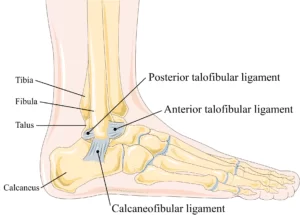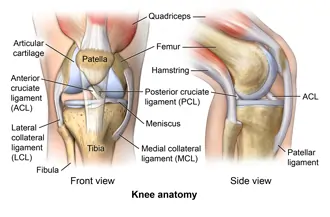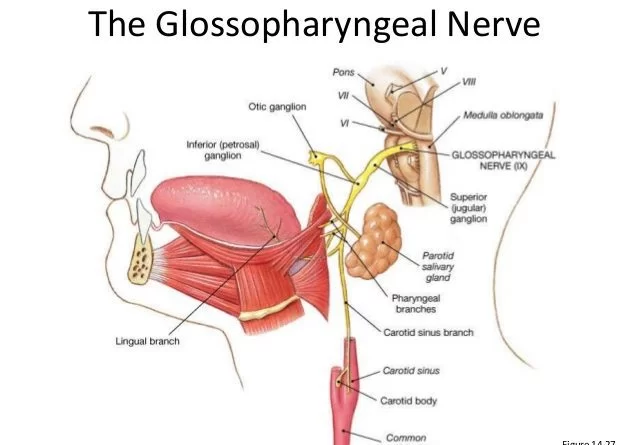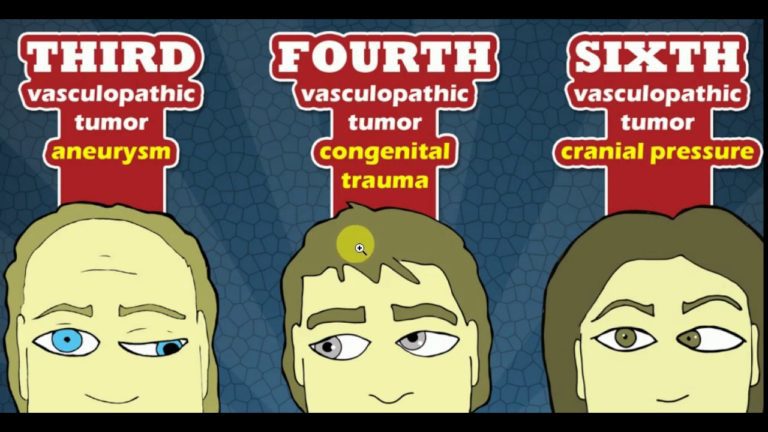Posterior Talofibular Ligament
Table of Contents
Introduction
The posterior talofibular ligament is a strong band of fibrous tissue that connects the posterior aspect of the lateral malleolus (bony prominence on the outside of the ankle) to the talus bone (one of the bones in the ankle joint). It is one of the three main ligaments that make up the lateral collateral ligament complex, which provides stability to the ankle joint.
The posterior talofibular ligament helps to prevent excessive inward rotation and inversion of the ankle and is commonly injured in ankle sprains. Understanding the anatomy and function of this ligament is important for diagnosing and treating ankle injuries.
Structure of the Posterior Talofibular Ligament
The posterior talofibular ligament (PTFL) is a strong, fibrous band that connects the talus bone of the foot to the fibula bone of the leg. It is one of the three major ligaments that make up the lateral ankle complex, along with the anterior talofibular ligament (ATFL) and the calcaneofibular ligament (CFL).
The lateral malleolus of the fibula’s posterior side gives rise to the posterior talofibular ligament, which attaches to the lateral tubercle of the talus bone. It runs obliquely downwards and backward, forming an angle of approximately 45 degrees with the horizontal plane.
The posterior talofibular ligament is composed of dense collagen fibers that are arranged in a parallel fashion. It is thicker and stronger than the ATFL and CFL, providing greater stability to the ankle joint. It also plays a key role in preventing excessive inversion or outward rolling of the foot.
So in general, the posterior talofibular ligament is an important structure that helps to maintain the stability and function of the ankle joint. Its location and orientation make it particularly effective at resisting excessive inversion forces, which can help to prevent ankle sprains and other injuries.
Attachment of the Posterior Talofibular Ligament
The posterior talofibular ligament (PTFL) originates from the posterior aspect of the lateral malleolus of the fibula, which is a bony prominence on the outer side of the ankle. Specifically, it arises from the groove between the lateral malleolus and the posterior border of the fibula.
From there, the posterior talofibular ligament runs obliquely downwards and backward towards the talus bone of the foot. It inserts onto the lateral tubercle of the talus, which is a small bony projection on the lateral side of the talus.
The insertion point of the posterior talofibular ligament is located just below and behind the insertion points of the anterior talofibular ligament (ATFL) and calcaneofibular ligament (CFL), which are the other two major ligaments of the lateral ankle complex. Together, these three ligaments form a triangular shape that provides stability to the ankle joint.
The posterior talofibular ligament is oriented at an angle of approximately 45 degrees with respect to the horizontal plane. This orientation allows it to resist excessive inversion or outward rolling of the foot, which is a common mechanism of ankle injury.
So in the end, the attachments of the posterior talofibular ligament are critical for their function in stabilizing the ankle joint and preventing injury. Its origin on the fibula and insertion on the talus create a strong connection that can withstand significant forces during weight-bearing activities.
Functions of the Posterior Talofibular Ligament
The posterior talofibular ligament (PTFL) plays a critical role in stabilizing the ankle joint and preventing excessive movement that can lead to injury. Here are some of the main functions of the posterior talofibular ligament:
Resists inversion: The posterior talofibular ligament is oriented at an angle of approximately 45 degrees with respect to the horizontal plane. This orientation allows it to resist excessive inversion or outward rolling of the foot, which is a common mechanism of ankle injury. When the foot is forced into inversion, the posterior talofibular ligament tightens and helps to prevent excessive movement of the ankle joint.
Limits plantar flexion: The posterior talofibular ligament also limits plantar flexion of the ankle joint. Plantar flexion is the motion that happens when the foot is pointed downwards, as in standing on your tiptoes. The posterior talofibular ligament helps to prevent excessive plantar flexion, which can also lead to an ankle injury.
Provides stability: Together with the anterior talofibular ligament (ATFL) and calcaneofibular ligament (CFL), the posterior talofibular ligament forms a triangular shape that provides stability to the ankle joint. These three ligaments work together to prevent excessive movement in all directions, helping to maintain proper alignment and reduce the risk of injury.
Supports weight-bearing activities: The attachments of the posterior talofibular ligament are critical for their function in stabilizing the ankle joint during weight-bearing activities such as walking, running, and jumping. The strong connection between the fibula and talus provided by the posterior talofibular ligament allows for the efficient transfer of forces through the ankle joint, helping to distribute weight evenly and prevent injury.
Overall, the posterior talofibular ligament is an important component of the lateral ankle complex and plays a critical role in stabilizing the ankle joint and preventing injury during weight-bearing activities.
Blood supply of the Posterior Talofibular Ligament
The posterior talofibular ligament (PTFL) receives its blood supply from the branches of the posterior tibial artery and the peroneal artery. These arteries provide the necessary nutrients and oxygen to the ligament to maintain its structural integrity and function.
The posterior tibial artery is the main branch of the popliteal artery and runs down the leg behind the tibia bone. It gives off several branches, including the fibular artery, which supplies blood to the lateral aspect of the leg and ankle joint. The fibular artery gives rise to the peroneal artery, which supplies blood to the lateral ankle ligaments, including the posterior talofibular ligament.
The peroneal artery also gives off a branch called the lateral tarsal artery, which supplies blood to the talus bone and the surrounding ligaments, including the posterior talofibular ligament. The lateral tarsal artery runs along the lateral side of the foot and ankle and provides an additional source of blood supply to the posterior talofibular ligament.
The blood supply to the posterior talofibular ligament is important for maintaining its strength and preventing injury. Without adequate blood flow, the ligament may become weakened and more prone to damage during weight-bearing activities. Therefore, maintaining a healthy blood supply to the posterior talofibular ligament is essential for optimal ankle function and injury prevention.
Injuries of the Posterior Talofibular Ligament
The posterior talofibular ligament (PTFL) can be injured during various activities that involve sudden or excessive twisting or rolling of the ankle. Some common activities that can cause posterior talofibular ligament injuries include:
- Sports: Participating in sports that involve jumping, running, cutting, and pivoting movements can put a lot of stress on the ankle joint and its ligaments, including the posterior talofibular ligament. Sports such as basketball, soccer, football, tennis, and volleyball are examples of high-risk sports for posterior talofibular ligament injuries.
- Uneven surfaces: Walking or running on uneven surfaces, such as rocky terrain or a bumpy road, can cause the ankle to twist or turn unexpectedly, leading to posterior talofibular ligament injuries.
- High heels: Wearing high-heeled shoes can alter the natural alignment of the foot and ankle, putting extra strain on the ligaments. This can increase the risk of posterior talofibular ligament injuries, especially if the heels are worn for extended periods.
- Falls: Falling from a height or tripping over an obstacle can cause the ankle to twist or bend in an unnatural way, leading to posterior talofibular ligament injuries.
- Overuse: Repeatedly performing activities that involve ankle movements, such as walking or running long distances, can cause overuse injuries to the posterior talofibular ligament over time.
- Improper warm-up: Failing to properly warm up before exercising or participating in sports can increase the risk of PTFL injuries by reducing the flexibility and strength of the ligaments.
Injuries to the posterior talofibular ligament can range from mild sprains to complete tears. Symptoms of a posterior talofibular ligament injury may include pain, swelling, bruising, stiffness, and difficulty bearing weight on the affected ankle. Treatment for posterior talofibular ligament injuries typically involves rest, ice, compression, and elevation (RICE), physical therapy, and in severe cases, surgery.
Symptoms of the PTFL Injury
The posterior talofibular ligament (PTFL) is a ligament located on the outside of the ankle joint that connects the talus bone to the fibula bone. When this ligament is injured, it can cause a range of symptoms, including:
- Pain: Pain is a common symptom of a posterior talofibular ligament injury. The pain may be sharp or dull and may be experienced on the outside of the ankle.
- Swelling: Swelling is another common symptom of a posterior talofibular ligament injury. The ankle may get swollen and tender to the touch.
- Bruising: Bruising may occur around the ankle joint due to the injury.
- Stiffness: Stiffness in the ankle joint may occur, making it difficult to move the ankle.
- Difficulty bearing weight: It may be difficult to bear weight on the affected ankle due to the pain and swelling.
- Instability: A posterior talofibular ligament injury can cause ankle instability, making it difficult to walk or participate in activities that require balance.
- Clicking or popping: In some cases, a clicking or popping sensation may be felt in the ankle joint when moving the foot.
It is very crucial to take medical attention if any of these symptoms are present, as untreated posterior talofibular ligament injuries can lead to chronic ankle instability and other complications.
Diagnosis of the PTFL Injury
Diagnosis of a posterior talofibular ligament injury typically involves a physical examination by a healthcare professional. During the exam, the healthcare provider will assess the ankle for pain, swelling, bruising, and instability. They may also move the ankle joint to check for a range of motion and any clicking or popping sensations.
Imaging tests may also be used to confirm the diagnosis and assess the extent of the injury. X-rays can help rule out any fractures or dislocations, while an MRI can provide a more detailed view of soft tissue injuries like ligament tears.
In some conditions, a stress test may be performed to assess ankle stability. This involves applying pressure to the ankle joint while the patient is standing or walking to see if there is any excessive movement or instability.
Once a diagnosis is created, treatment options should be discussed with the patient. These may include rest, ice, compression, and elevation (RICE), physical therapy, bracing or taping, and in severe cases, surgery.
Treatment of the Posterior talofibular Ligament Injury
The posterior drawer test
The posterior drawer test is a physical exam maneuver used to assess the stability of the ankle joint, specifically the posterior talofibular ligament (PTFL). This test is typically performed by a healthcare professional during a physical examination of the ankle.
To perform the posterior drawer test, the patient is typically seated or lying down with their knee bent and foot flat on the exam table. The healthcare provider will then grasp the heel of the affected foot with one hand and place the other hand on the front of the ankle, just above the ankle joint.
Next, the healthcare provider will apply gentle pressure to the back of the heel, attempting to move it backward relative to the lower leg. If there is excessive movement or instability in the ankle joint, this may indicate a posterior talofibular ligament injury.
During the test, the healthcare provider will also look for any clicking or popping sensations, as well as assess the patient’s pain levels and range of motion. Depending on the severity of the injury, additional imaging tests like X-rays or an MRI may be necessary to confirm the diagnosis and assess the extent of the damage.
So in general, the posterior drawer test is a simple and non-invasive way to assess ankle stability and diagnose posterior talofibular ligament injuries. It is typically performed as part of a comprehensive physical examination for ankle injuries.
Conservative treatment
The PTFL (Posterior Talofibular Ligament) is a ligament that connects the talus bone of the foot to the fibula bone of the lower leg. It is responsible for stabilizing the ankle joint and preventing excessive outward rotation of the foot. When this ligament is injured, conservative treatment may be recommended before considering surgical options.
Conservative treatment of the posterior talofibular ligament typically involves a combination of rest, ice, compression, and elevation (RICE). This is useful for reducing pain, swelling, and inflammation in the injured area. Non-steroidal anti-inflammatory drugs (NSAIDs) may also be prescribed to further reduce pain and inflammation.
Physical therapy is another important aspect of conservative treatment for posterior talofibular ligament injuries. A physical therapist can help patients with stretching and strengthening exercises that can help to improve the range of motion and stability in the ankle joint. This may include exercises such as ankle circles, calf raises, and balance training.
In some conditions, a brace or cast may be recommended to immobilize the ankle and allow the ligament to heal. This may be necessary for more severe injuries or for patients who are at risk of re-injury.
In general, conservative treatment for posterior talofibular ligament injuries aims to reduce pain and inflammation, improve the range of motion and stability in the ankle joint, and promote healing of the injured ligament. With proper care and rehabilitation, many patients are able to make a full recovery without the need for surgery.
Physiotherapy treatment
Physiotherapy treatment of the posterior talofibular ligament typically involves a combination of stretching and strengthening exercises, as well as other modalities such as manual therapy and electrical stimulation.
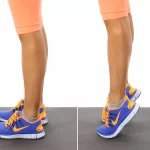
Stretching exercises are important for improving the range of motion in the ankle joint and reducing stiffness. A physical therapist may prescribe exercises such as ankle circles, calf stretches, and heel drops to help stretch the muscles and ligaments around the ankle.
Strengthening exercises are also important for improving stability in the ankle joint and preventing re-injury. A physical therapist may prescribe exercises such as calf raises, toe raises, and ankle dorsiflexion exercises to help strengthen the muscles around the ankle.
Manual therapy techniques such as massage and joint mobilization may also be used to help reduce pain and inflammation in the affected area. This can help to improve circulation and promote the healing of the injured ligament.
Electrical stimulation may also be used to help reduce pain and promote healing. This involves using a small electrical current to stimulate the muscles and tissues around the ankle, which can help to reduce pain and improve circulation.
Overall, physiotherapy treatment for posterior talofibular ligament injuries is designed to help reduce pain and inflammation, improve the range of motion and stability in the ankle joint, and promote the healing of the injured ligament. With proper care and rehabilitation, many patients are able to make a full recovery without the need for surgery.
Risk factors
There are several risk factors that can increase the likelihood of a posterior talofibular ligament injury. These include:
Ankle sprains: A previous ankle sprain can weaken the ligaments in the ankle, making them more susceptible to injury.
Sports participation: Certain sports, such as basketball, soccer, and football, involve a lot of jumping, pivoting, and sudden changes in direction, which can increase the risk of an ankle injury.
Overuse: Repeated stress on the ankle joint, such as from running or jumping, can lead to overuse injuries, including posterior talofibular ligament injuries.
Anatomical abnormalities: Certain anatomical factors, such as high arches or flat feet, can alter the mechanics of the foot and ankle, increasing the risk of injury.
Poor footwear: Wearing shoes that do not provide adequate support or stability for the ankle can increase the risk of injury.
Age: posterior talofibular ligament injuries are more common in older individuals, as the ligaments and tendons in the ankle can become weaker and less flexible with age.
Obesity: Excess weight can put additional stress on the ankle joint, increasing the risk of injury.
Poor conditioning: Weak muscles and poor flexibility in the ankle and lower leg can increase the risk of injury during physical activity.
So in the end, individuals who participate in sports or activities that involve repetitive stress on the ankle joint, as well as those with anatomical abnormalities or poor conditioning, may be at increased risk of a posterior talofibular ligament injury.
How to prevent injuries of the posterior talofibular ligament?
Preventing posterior talofibular ligament injuries involves a combination of strategies that can help strengthen the ankle joint, improve flexibility, and reduce the risk of overuse and traumatic injuries. Here are some tips to prevent posterior talofibular ligament injuries:
- Wear proper footwear: Choose shoes that give proper support and stability to your feet and ankles. Look for shoes with a firm heel counter, a cushioned sole, and good arch support.
- Warm-up and stretch: Before engaging in physical activity, warm up your muscles and stretch your ankles, calves, and feet. Warm-ups can help improve flexibility and lower the risk of injury.
- Strengthen your ankle muscles: Incorporate exercises that target the muscles in your ankles and lower legs, such as calf raises, ankle circles, and resistance band exercises. Strengthening these muscles can help in improving stability and reducing the risk of injury.
- Use proper technique: When participating in sports or activities that involve jumping, pivoting, or sudden changes in direction, use proper technique to reduce the risk of injury.
- Take breaks: If you engage in repetitive activities such as running or jumping, take breaks to rest your ankles and reduce the risk of overuse injuries.
- Maintain a healthy weight: More than normal weight can create additional stress on your ankles and increase the risk of injury. Maintaining a normal weight can reduce this risk.
- Seek treatment for ankle injuries: If you experience an ankle injury, seek prompt medical treatment to prevent further damage and reduce the risk of long-term complications.
By following these tips, you can reduce the risk of posterior talofibular ligament injuries and enjoy your favorite activities without fear of injury.
FAQ
The posterior talofibular ligament is a strong band of tissue that connects the back of the fibula bone to the talus bone in the ankle joint.
The function of the posterior talofibular ligament is to provide stability to the ankle joint by preventing excessive inward and outward movement of the talus bone.
The posterior talofibular ligament can be injured by twisting or rolling the ankle, landing awkwardly on the foot, or through direct trauma to the ankle.
The symptoms of a posterior talofibular ligament injury include pain, swelling, bruising, tenderness, stiffness, instability, and difficulty bearing weight on the affected ankle.
A posterior talofibular ligament injury is diagnosed through a physical examination, X-rays, MRI, or CT scans.
The treatment for a posterior talofibular ligament injury depends on the severity of the injury. Mild injuries can be treated with rest, ice, compression, and elevation (RICE), while more severe injuries may require immobilization, physical therapy, or surgery.
The recovery time for a posterior talofibular ligament injury varies depending on the severity of the injury and the treatment received. Mild injuries may take a few weeks to heal, while more severe injuries may take several months to fully recover.
A posterior talofibular ligament injury can be prevented by wearing proper footwear, using ankle braces or supports during physical activity, warming up properly before exercising, and avoiding activities that put excessive stress on the ankle joint.

